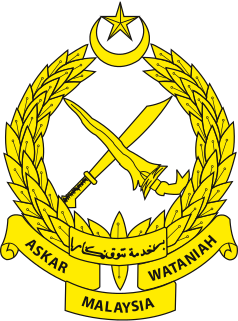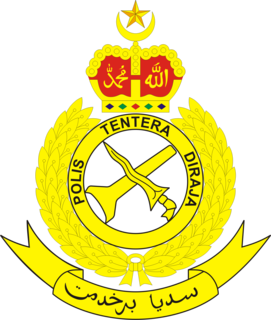A signal corps is a military branch, responsible for military communications (signals). Many countries maintain a signal corps, which is typically subordinate to a country's army.

The Malaysian Army is the land component of the Malaysian Armed Forces. Steeped in British Army traditions, the Malaysian Army does not carry the title ‘royal’ as do the Royal Malaysian Navy and the Royal Malaysian Air Force. Instead, the title is bestowed on selected army corps and regiments who have been accorded the honour by the Yang di-Pertuan Agong, who is the Supreme Commander of the Malaysian Armed Forces.

The Rejimen Askar Wataniah is the military reserve force of the Malaysian Army.

The Rejimen Artileri DiRaja is the artillery corps of the Malaysian Army. Rejimen Artileri DiRaja was formed in Kajang on 15 August 1957 when a single battery was formed, drawn from Malay personnel formerly serving with the British Army's Royal Regiment of Artillery. Today Rejimen Artileri DiRaja is a modern fighting arm providing direct fire support to Malaysian Army units using field artillery pieces and MLRS.

The Malaysian Army Aviation is the army aviation branch of the Malaysian Army. Currently equipped with helicopters in the liaison, transport and light attack roles. The Malaysian Army also plans to equip PUTD with dedicated attack helicopters in support of Malaysian Army units.

Royal Intelligence Corps is a Malaysian intelligence agency specialising in intelligence gathering, intelligence analysis, psychological warfare, surveillance, espionage, reconnaissance and counter-intelligence operations. It also manages the propaganda and counter-propaganda effort of the Malaysian Army.
Royal Army Engineers Regiment is a group combat support military units of the Malaysian Army that provides combat engineering and other engineering support to the Malaysian Army.

The Kor Polis Tentera DiRaja is the military police branch of the Malaysian Army. Referred to as the "Redcaps" like their British counterpart or, more popularly, known as "MPs", the Kor Polis Tentera DiRaja keep discipline within the Army ranks and ensure security at Malaysian Army installations.
Royal Electric & Mechanical Engineer Corps is a corps of the Malaysian Army that is responsible for the maintenance of all vehicles, mechanical and electrical equipment of the Malaysian Army, with the exception of heavy equipments of the Rejimen Askar Jurutera DiRaja and signals equipment of the Rejimen Semboyan DiRaja.

Gerak Khas, or Grup Gerak Khas, also spelled Gerakhas, is a Malaysian Army special forces unit that performs special operations missions such as direct action, unconventional warfare, sabotage, counter-terrorism, and intelligence gathering. Gerak Khas was founded in 1965 during the Indonesia-Malaysia conflict, and they gained worldwide fame and recognition after successfully pacifying the communist insurgency in Malaysia's jungles between 1968 and 1989.

The Pasukan Khas TUDM – it is better known as PASKAU – is the special operations force of the Royal Malaysian Air Force. Its main functions are to carry out high-value target protection, ground forward air controller, combat search and rescue and rescuing downed aircrew assignments. PASKAU is also tasked as the principal anti-hijack response force for military and civil aircraft in Malaysia. This task was taken over from Grup Gerak Khas. All PASKAU members are airborne and commando-trained and can be deployed behind enemy lines via air, land and sea to assist in target designation for the Malaysian Armed Forces and RMAF missions. The PASKAU Headquarters is known as RMAF Regiment.

The Royal Brunei Armed Forces (RBAF); Malay: Angkatan Bersenjata Diraja Brunei, (ABDB), is the collective term for the military forces of the sultanate of Brunei Darussalam. They consist of the Royal Brunei Land Forces (RBLF), the Royal Brunei Navy (RBN), and the Royal Brunei Air Force (RBAirF).

The Malaysian Army Training and Doctrine Command, known as PL&DTD and PLDTD, is a military command in charge of all Malaysian Army training centres, facilities and museum.

The 8th Battalion (Parachute), Royal Ranger Regiment, better known as the 8 RRD or 8 RRD (Para) – abbreviation from its local name, is a battalion-sized airborne infantry from the Royal Ranger Regiment of the Malaysian Army. On 10 October 1994 the 8 RRD became part of the 10th Parachute Brigade. The 8 RRD is the first infantry unit in the Malaysian Army transformed from a conventional to an airborne unit.

The 10th Squadron (Parachute), Royal Army Engineers Regiment is a battalion-sized airborne sapper from the Malaysian Army's Royal Army Engineers Regiment. 10 SQN RAER (Para) has been a part of the 10th Parachute Brigade since 10 October 1994 and is tasked with providing engineering support to the brigade.
The 9th Battalion (Parachute), Royal Malay Regiment, abbreviated 9 RAMD (Para) from its local name, is a battalion-sized airborne infantry unit of the Malaysian Army's Royal Malay Regiment. Since 10 October 1994, 9 RAMD has been a part of the 10th Parachute Brigade.
The Medical Company (Parachute), Royal Medical and Dental Corps, also known as Para Viper or abbreviated KPP from its local name, is a company-sized airborne combat medic unit of the Malaysian Army's Royal Medical and Dental Corps. It has been a part of the 10th Parachute Brigade since 1994 and is responsible for providing medical support to the brigade.

The 21st Special Service Group is a command for Malaysian Army special forces, the Gerak Khas. The 21 SSG and 10th Parachute Brigade are elite fighting formations of the Malaysian Army. Both units are independent units under the Malaysian Army and report directly to the Chief of Army. The headquarters of the 21 SSG are at Iskandar Camp in Mersing, Johor.

The 11th Strategic Division, stylized XI Division, was a division-sized combat formation of the Malaysian Army.
The 18th Battalion (Parachute), Royal Malay Regiment, abbreviated 18 RAMD (Para) from its local name, is a battalion-sized airborne infantry unit of the Malaysian Army's Royal Malay Regiment. The 18 RAMD is the newest conventional infantry unit to be promoted to an airborne unit, and they have now officially been part of the Malaysian Army's elite 10 Parachute Brigade since 21 February 2018.















